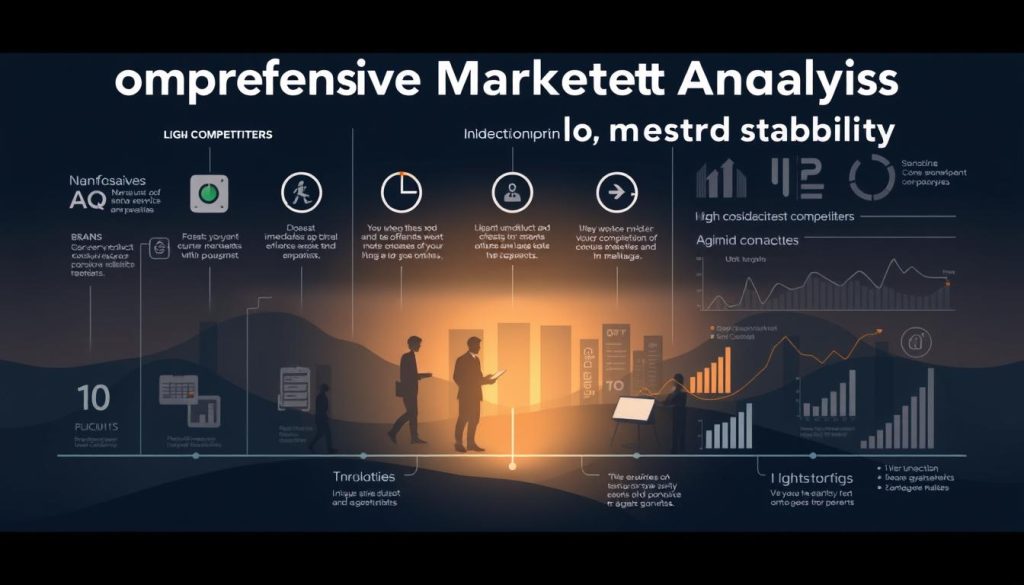A few years ago, Marie left a secure job in Paris to work solo. She had skills, a clear offer, and hope. But she lacked the steady plan that keeps income predictable through shifts in demand.
We start with a simple story because it shows why understanding matters. You need reliable information about size, segments, and buying habits to protect your income as an independent professional in France.
This introduction will show how a practical blend of qualitative insight and quantitative data helps you set offers, pick clients, and price services with confidence.
Along the way, we explain why investors, banks, and partners read a solid plan as proof of your professionalism. You will see an example workflow you can follow daily without getting stuck.
Table of Contents
Key Takeaways
- Define your landscape with clear steps so you protect career stability.
- Blend interviews and numbers to map customers and demand.
- Document assumptions and sources for long-term review.
- Use a repeatable workflow to avoid paralysis and stay focused.
- Translate findings into practical choices on clients, offers, and pricing.
Why a market analysis is your foundation for career stability in France today
Understanding territorial data and client needs is the first safeguard for your career. Public sources like INSEE, CCI/CMA and PRISM tell you where demand is rising, which companies hire, and what local purchasing power looks like.
We recommend grounding your study on four pillars: offer, demand, environment, and distribution. Use field surveys, short questionnaires, official sites, and professional networks to gather data that matters to your industry.
Ask disciplined questions: who are the buyers, where are they, how many exist, and at what price will they buy? Clear questions help you pick clients and avoid spreading yourself thin.
- Mix field feedback and desk work to validate assumptions fast.
- Document sources so your marketing and pricing rest on verifiable facts.
- Treat the study as a living asset and update it periodically to protect monthly sales and business resilience.
What is a market analysis and how it differs from market research
Start by separating customer discovery from sector-wide review to avoid mixed conclusions.
Market analysis covers size, segments, buying patterns, competitors, and the regulatory environment. It measures value and structure so you can size opportunity and risk.
Market research focuses on customers: motivations, objections, and purchase triggers. Use short interviews and surveys for this work.
Qualitative vs. quantitative insights you need
Qualitative inputs reveal expectations and objections. Quantitative data gives size, growth, and purchase frequency.
- Qualitative: interviews, user journeys, objections.
- Quantitative: spend estimates, customer counts, purchase cadence.
Linking industry, market, and competition
Connect sector trends, regulation, and barriers to entry with customer behavior. This clarifies where your offer can win.
| Focus | Question answered | Method | Outcome |
|---|---|---|---|
| Size & value | How big is the opportunity? | Public data, financial reports | Realistic revenue ceiling |
| Customer needs | Why customers buy? | Surveys, interviews | Product fit & messaging |
| Competition | Who blocks entry? | Competitive watch | Positioning gaps |
Next steps: translate findings into conversion hypotheses and track validations. Document data sources and assumptions, then validate with interviews or small campaigns. For a guide on mapping competitors online, see competitive watch techniques.
Define your industry overview to size trends, growth, and regulations
Begin with a concise snapshot of the industry: size, recent trends, and the rules that shape who can start and scale.
Collect the core metrics that let you turn public data into an operational plan. Use INSEE and sector federations for France, and cross-check with Statista or the U.S. Census when comparable figures help clarify trend direction.
Key metrics to capture
- Market size: total spend and annual growth rate to see the opportunity ceiling.
- Number of active firms: who competes, typical company size, and consolidation dynamics.
- Barriers to entry: licenses, certifications, capital needs, and compliance costs that slow a new product or service.
| Metric | What to measure | Why it matters |
|---|---|---|
| Size & growth | Total spend, CAGR | Frames realistic sales potential |
| Structure | Firm counts, business models | Shows where margins and partners lie |
| Regulation | Licenses, upcoming changes | Affects pricing and time to revenue |
Example: take the sector growth rate, apply a conservative share of total spend that matches your capacity, and produce a first‑year sales envelope. This keeps forecasts tied to verifiable data and to what you can deliver.
Identify and segment your target market with actionable demographics and behaviors
Knowing who will buy, where they are, and what they value reduces guesswork in outreach. Target market sizing defines the number of potential customers, their demographics, location, and core needs. This gives you a clear starting point for sales planning.
Demographics, location, and psychographics that matter
Describe ideal customers by age, role, and context. Add psychographic signals: values, service preferences, and risk tolerance. These traits shape messaging and channel choice.
From total addressable market to serviceable segments
Move from a broad TAM to a realistic segment you can serve today. Estimate the number of buyers in your geography and expected purchase frequency to size workload and pipeline.
Signals from purchasing behavior and trends over time
Track seasonality, budget cycles, and repeat rates. Use short interviews and micro-surveys to validate assumptions fast. Align segment selection to your positioning so prospecting time targets the most promising profiles.
- Define clear personas with age ranges and purchase contexts.
- Quantify the number of likely buyers and expected sales cadence.
- Validate with quick field research to refine offers without heavy investment.
Data sources and tools for France: INSEE, PRISM, CCI/CMA, and beyond
Identify which French datasets and on-the-ground checks will tell you where customers and companies concentrate.
Official statistics and territorial portraits to map demand
INSEE gives territorial portraits, company directories, and baseline economic data. Use it to set the size and trends of local demand.
PRISM supplies sector studies useful for comparisons and trend snapshots. Where public data is thin, these studies fill gaps in information.
CCI/CMA offer advisory help, low-cost studies, or local figures. They can validate assumptions and point to regional programs that support small business growth.
Field surveys, questionnaires, and competitive watch
Combine official sources with quick field research. Short questionnaires and interviews test willingness to pay and buying triggers.
- Lightweight competitive watch: scan public registries, company directories, and trade press to track rivals and new entrants.
- Structured data plan: assign each source the questions it answers—size, customers, sales cadence, or company counts.
- Refresh cadence: update core datasets quarterly and run short surveys twice a year to keep decisions current.
When a decision is strategic or costly, commission deeper research. For everyday choices, combine official figures with simple field checks until you reach a good enough confidence level.
Competitive analysis: mapping direct, indirect competitors and your advantage

A clear inventory of local and remote rivals shows where you must be better and where you can avoid head-on fights.
List direct providers and indirect alternatives your target uses today. Include DIY solutions and substitute services. This clarifies which niches are crowded and which are underserved.
How to capture relative strengths, weaknesses and barriers
Rate each competitor on response time, pricing, service range, and location. Note barriers to entry such as patents, prime addresses, or exclusive supplier ties.
- Objective rating: use the same scale for all companies so comparisons are fair.
- Barriers: identify protections that make some positions safer for incumbents.
- Example: slow response times by incumbents can become your quick-win.
Differentiation through product, service, price, and location
Choose levers where you can sustain an advantage: hours, ambiance, guarantees, or proximity. Link those levers to your pipeline by prioritizing segments where time-to-win is short.
« Capture tactical metrics — win/loss reasons and price sensitivity — and refine your approach as real sales data arrives. »
Pricing strategy and sales forecasting that align with your positioning
Your price must reflect the position you want to hold. High prices signal quality and need clear proof: branding, staff training, and superior customer service. Low-price approaches work only with tight processes and consistent messaging from marketing to delivery.
Value signaling and customer expectations
Align price, product, and the company touchpoints so customers feel the promised value. Use guarantees, packaging, and response time as tangible signals.
Building realistic forecasts and tracking against actuals
Forecast from addressable spend, conversion rate, average deal size, and sales cycle length. Avoid the trap of taking 1% of a large market without a client acquisition plan.
- Choose a model: project, retainer, or tiered pricing that preserves margin.
- Forecast method: number of leads × conversion × deal size = monthly sales.
- Track loop: forecast vs. actuals, record variance reasons, and adjust quickly—use tools like LivePlan to automate comparisons.
« Test sensitivity: if conversions fall 10% or deal size rises 15%, update your resource plan and pricing fast. »
Leverage geomarketing: use spatial analysis to see where demand concentrates
Spatial views turn abstract figures into visible clusters of opportunity and logistical reality.
WIGeoWeb and similar tools show data down to ZIP-code level. They reveal neighborhood effects, accessibility, and routes that raw tables mask.
We compare national, regional, city, and ZIP views so you pick the right spatial level for your question. Too coarse hides local pockets; too granular adds cost and noise.
Choosing the right geographic level
National views give trend context. Regional and city maps point to promising zones. ZIP or neighborhood maps expose service costs and micro-clusters.
- Map your own customer addresses to spot coverage gaps and travel-time barriers.
- Link device signals—like mobile phones—to local channel preferences for smarter outreach.
- Avoid buying ultra‑detailed layers unless they answer a specific decision question.
- Refresh map layers regularly as new contracts and population shifts change priorities.
| Scope | Typical use | Benefit | Risk |
|---|---|---|---|
| National | Strategic planning | Context and trend tracking | Misses local nuances |
| Regional / City | Territory selection | Balances signal and scale | May smooth micro-clusters |
| ZIP / Neighborhood | Route planning, pilots | Pinpoints demand pockets | Costly, can dilute decisions |
| Client overlay | Coverage & gap analysis | Improves service economics | Requires clean address data |
Use geographic analysis to refine where you spend time and budget. This approach reduces uncertainty and helps you reach the right customers with the right channels.
Customer analysis on the map: find your best customers and service gaps
Map-based customer study turns raw CRM records into clear sales priorities across your territory.
We start with your CRM data to tag accounts by value, frequency, and loyalty. Then we map those tags to see geographic clusters, travel time, and adjacency effects that affect retention and cost.
ABC segmentation to protect time and margin
Use a classic ABC method: A are the high-value clients, B are promising, C are low-return. The Pareto rule often holds—top accounts drive most sales—so you focus resources where they pay off.
- Map customers to reveal travel burdens and retention pockets.
- Run an ABC breakdown to prioritize A accounts for proactive work.
- Define service tiers so A clients receive priority attention while B can be nurtured.
- Locate gaps—areas with few clients but strong potential—and rebalance routes.
| Tier | Focus | Metric |
|---|---|---|
| A | Protect & retain | Top 20% of sales |
| B | Grow with touchpoints | Medium value, upsell potential |
| C | Refine or reprice | Low frequency, high cost-to-serve |
« Protect A, grow B, and reprice or rationalize C to keep weekly capacity and profitability balanced. »
Turn insights into a short action plan: mark the number of A accounts, set routes by proximity, and schedule proactive visits. This practical step helps you dominate local market pockets while controlling costs.
Target group analysis: locate potential customers and media-ready audiences
Pinpointing where high-potential audiences cluster is the fastest way to focus your outreach and budget. We show how to combine simple variables into actionable maps you can use immediately.
Start by selecting practical variables: age, household status, local purchasing power, and basic media habits. These demographics form the building blocks for useful maps.
Overlaying characteristics to find dense pockets
Use WebGIS at ZIP or grid level to overlay two or more traits. This isolates pockets of qualified people and highlights the best locations to test offers.
- Map where your chosen people concentrate and export audience grids for agencies.
- Include device signals so you see how mobile phones shape channel choice.
- Compare audience maps with existing customer clusters to spot under-addressed zones.
- Exportable data speeds activation and shortens time to first results.
By focusing on location-based pockets, you reduce waste and reach the right people faster in a local market context.
Determine market shares and penetration to prioritize territories
Turn imperfect local figures into usable share estimates so decisions move from guesswork to action. We show how to measure absolute and relative share, accept fuzzy inputs, and set clear priorities across territories.
Absolute vs. relative share and pragmatic data use
Absolute share equals your sales as a portion of total volume. Relative share compares you to the largest competitor. Example: if 1,000 cars exist and batteries last five years, annual replacement volume is 200 units; selling 50 equals a 25% share.
WIGeoWeb recommends using proxy indicators when exact figures are not available. Accepting fuzzy data with documented caveats lets you act rather than wait for perfect inputs.
Penetration insights to guide expansion or right-sizing
- Estimate total volume from proxies, then compute share at national, regional, and ZIP levels.
- Pair share with penetration (customers reached vs. total potential) to spot growth or saturation.
- Use trends in share to align resources: invest where share rises, hold or cut where it falls.
« Focus on usable figures and clear caveats; decisions backed by good-enough data protect time and margin. »
Portfolio analysis to balance performance and potential across products and locations

Balance what performs today with what can grow tomorrow to protect revenue and time. A compact portfolio view helps you choose where the company should invest and where to conserve resources.
Applying the BCG matrix to branches, sales areas, and product ranges
The BCG grid compares performance (relative share) to potential (growth). It places points into four zones: Question Mark, Star, Cash Cow, and Poor Dog.
Use spatial data so each branch or sales area becomes a point with two metrics: current revenue or clients served, and local growth or pipeline proxy.
- Choose practical indicators: revenue, clients served, and sales conversion as performance metrics.
- Choose potential proxies: local growth rate, pipeline size, or device-based demand signals.
- Classify: Stars = invest, Cash Cows = protect, Question Marks = test, Poor Dogs = exit or reprice.
Build a one-page portfolio that shows each product and location on the same grid. This view makes trade-offs visible and guides weekly priorities.
« Rebalance time: shift prospecting toward high-potential zones while keeping service levels on core cash generators. »
Example: if one branch delivers 35% of revenue but sits in a low-growth zone, protect its operations while increasing outreach in nearby high-growth pockets. This practical step helps the company scale offers and reallocate the product range without disrupting cash flow.
From analysis to action: timeline, resources, and financial forecast essentials
Turn your findings into a clear 90-day plan that ties outreach to cash flow and client milestones. This short timeline keeps the company focused on concrete wins while you build a stable business base in France.
We convert insights into executable steps with measured goals for marketing tests, distribution trials, and supplier terms. The plan lists who does what, by when, and which metrics prove progress.
Mix-marketing, distribution channels, and supplier strategy
Define the marketing mix that fits your offer: digital outreach, local partnerships, and direct sales. Test two channels fast and scale the best performer.
- Set channel KPIs tied to sales and conversion.
- Negotiate supplier terms that protect margin and delivery timing.
- Specify service-level steps to stabilize client experience.
Linking the plan to P&L, balance sheet, financing plan, and cash flow
In France, a robust forecast includes a 3-year profit & loss account, a projected balance sheet, a 3-year financing plan, and a 12-month cash flow schedule.
- Costs to model: purchases, storage, rent, insurance, taxes, supplies, salaries, depreciation.
- Financing needs: working capital, fixed assets, loan repayments; resources: equity, loans, operating cash flow.
- Quantify resources: tools, subscriptions, and employee time against realistic sales and seasonality.
« Focus early on critical questions — conversion rates and payment terms — and bake answers into your cash plan. »
Governance: monthly variance reviews, quarterly re-forecast, and semiannual strategy checks keep the company adaptive and protected.
Conclusion
,Finish by locking in decisions: who does what, when, and what success looks like.
We recap a clear path: an industry overview, target segmentation, competitive analysis, pricing, and a forecast that ties to cash flow. Spatial work—customer maps, share and penetration—gives you local clarity for France.
Save your sources, document assumptions, and keep short examples to speed updates. That practice builds understanding and preserves the advantage you gain from good data.
Three steps to act this week: list the three items you exactly need, assign owners, and book a review slot. Do these to protect income and guide business growth with confidence.
FAQ
What is a comprehensive market analysis for career stability?
A comprehensive market analysis evaluates demand, customers, competitors, and regulatory context to help professionals build a stable independent career. It combines quantitative data (size, growth rates) and qualitative insights (customer needs, buying behavior) so you can position services, set prices, and forecast revenues with confidence.
Why is a market analysis essential for career stability in France today?
In France, economic conditions, regional differences, and regulatory rules influence demand and costs. A focused study helps you identify growth areas, adapt to local purchasing power, and anticipate changes from institutions like INSEE or local Chambers of Commerce, reducing risk when you launch or scale your activity.
How does a market analysis differ from market research?
Market research usually gathers specific data points or customer feedback via surveys and tests. A market analysis synthesizes those inputs with industry metrics, competitor maps, and financial forecasts to form a strategic view—linking customer insight to business decisions and operational planning.
What qualitative versus quantitative insights should I collect?
Collect quantitative metrics such as market size, growth rate, and sales volumes. Add qualitative insights like customer motivations, unmet needs, and competitor reputation. Together, these reveal where to position your offer and which segments will be most receptive.
How do I define an industry overview for sizing trends and regulations?
Map the industry’s total addressable size, recent growth, and regulatory constraints. Track barriers to entry, typical margins, and standard distribution channels. Use public data sources, trade reports, and interviews with sector experts for a realistic picture.
Which key metrics should I capture first?
Prioritize market size, annual growth rate, customer acquisition cost, lifetime value, and barriers to entry. These core indicators guide pricing, resource allocation, and the speed of market entry.
How do I segment my target market with useful demographics and behaviors?
Combine demographics (age, income, family status), geography (region, city, ZIP code), and psychographics (values, needs). Then narrow from total addressable market to serviceable segments that match your capabilities and revenue targets.
What signals from purchasing behavior should I monitor?
Track frequency of purchase, preferred channels (online vs. in-person), device usage such as mobile phones, average spend, and seasonality. These signals inform product mix, channel strategy, and customer service design.
What reliable data sources and tools are available for France?
Use INSEE for official statistics, PRISM for territorial insights, and local CCI/CMA reports for business context. Complement with paid tools for geomarketing, field surveys, and competitive monitoring to validate local demand.
How do I run field surveys and competitive watch effectively?
Design short questionnaires focused on decision drivers, distribute via targeted panels or in-person intercepts, and triangulate results with mystery shopping and competitor price monitoring. Keep samples representative of your target segments.
How should I map direct and indirect competitors and assess my advantage?
List competitors by proximity, price point, and service scope. Score strengths and weaknesses across product, service, price, and location. Identify gaps you can exploit, like superior customer experience or niche specialization.
How do I differentiate through product, service, price, and location?
Differentiate by focusing on a clear value proposition: unique features, tailored service protocols, transparent pricing, and choosing locations based on footfall and demographic fit. Communicate this consistently in marketing and operations.
What pricing strategy and sales forecasting methods should I use?
Base pricing on perceived value, competitor benchmarks, and cost margins. Create forecasts from top-down market share scenarios and bottom-up sales funnels. Update forecasts regularly by comparing planned versus actual results.
How do I build realistic financial forecasts?
Use conservative assumptions for conversion rates and customer retention. Model multiple scenarios (base, optimistic, pessimistic), link forecasts to P&L and cash flow, and ensure you have runway for slower-than-expected uptake.
How can geomarketing help find where demand concentrates?
Geomarketing overlays customer and sales data on maps to reveal high-potential zones by region, city, or ZIP code. This helps prioritize openings, targeted advertising, and door-to-door prospecting while avoiding low-return areas.
What granularity pitfalls should I avoid when buying external data?
Avoid over-reliance on highly granular datasets that lack sample size or that are outdated. Check collection methods, update frequency, and whether data aligns with your segments to prevent misleading conclusions.
How do I identify best customers and service gaps using customer analysis?
Use ABC analysis to classify customers by revenue and profitability, map service coverage, and spot underserved zones. Then allocate resources to retain A customers and convert promising B segments.
What is target group analysis and how does it guide media planning?
Target group analysis profiles customers by age, purchasing power, and media habits (including mobile usage). Use these profiles to select channels, craft messages, and schedule campaigns where your audience spends time.
How do I determine market share and penetration to prioritize territories?
Compare your sales to total sales in the territory (absolute and relative share). Use pragmatic adjustments for incomplete data and focus on areas where penetration gains deliver the best ROI for expansion or consolidation.
How can I apply portfolio analysis like the BCG matrix to branches and products?
Classify branches or products as Stars, Cash Cows, Question Marks, or Dogs based on growth and relative share. Allocate investment to Stars and promising Question Marks, manage Cash Cows for profitability, and consider divestment for Dogs.
What operational steps turn analysis into action?
Define a timeline, required resources, and clear KPIs. Plan marketing mix, distribution channels, and supplier agreements. Link initiatives to P&L forecasts, balance sheet impacts, and a financing plan to ensure cash flow stability.
Which team roles and skills are critical for this work?
Essential roles include a data analyst, commercial lead, field researcher, and finance manager. Combine technical skills with local knowledge and customer-facing experience to execute the plan reliably.





